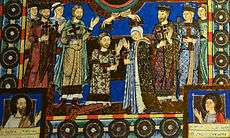Guelph Treasure


The Guelph Treasure (German: Welfenschatz) is the collection of medieval ecclesiastical art originally housed at Brunswick Cathedral in Braunschweig, Germany. Most of the objects were removed from the cathedral in the 17th century and dispersed in the 1930s.
The Treasure takes its name from the princely House of Guelph of Brunswick-Lüneburg.
The Guelph Treasure passed from Brunswick Cathedral into the hands of John Frederick, Duke of Brunswick-Lüneburg, in 1671, and remained in the Court Chapel at Hannover until 1803.
In 1929 Ernest Augustus, Duke of Brunswick, sold 82 items to a consortium of Frankfurt art dealers Saemy Rosenberg, Isaak Rosenbaum, Julius Falk, Arthur Goldschmidt and Zacharias Hackenbroch. Items from the Treasure were exhibited in the United States in 1930–31.[1] Cleveland Museum of Art purchased nine pieces and more were sold to other museums and private collectors.
In 1934 the remaining 40 pieces of the collection, which had been retained by several German-Jewish art dealers from Frankfurt, were purchased for 4.25 million Reichsmarks via Wilhelm Stuckart by the Prussian State under its Prime Minister Hermann Göring and displayed in Berlin.
The Berlin portion of the Guelph Treasure is now exhibited at the Bode Museum in Berlin.
Restitution claims
In 2008 a case for restitution was lodged in Germany by the heirs of the Jewish art dealers over the pieces sold in 1934. In March 2014 the Limbach Commission, an Advisory body to the German government, concluded that the treasure should not be handed over as the case did not meet the criteria defining a forced sale due to Nazi persecution.[2]
However, in February 2015, the heirs to the Jewish art dealers[3] sued Germany and the Bode Museum in the United States District Court for the District of Columbia in order to recover the treasure. A few days before Germany declared the collection for a national cultural treasure, meaning the art pieces can no longer leave the country without the explicit permission of the country's culture minister. It is unclear if the German Culture Minister Monika Grütters was aware of the US lawsuit at the time of the announcement.
Holocaust Expropriated Art Recovery Act
A case against Germany has been brought in the United States under the terms of the Holocaust Expropriated Art Recovery Act ("Hear Act"), allowing the heirs of victims of the Nazi regime to file restitution claims in the US. On 31 March 2017, a Washington DC federal judge denied Germany's motion to dismiss a lawsuit seeking to recover the Guelph Treasure.[4][5]
See also
 Gospels of Henry the Lion showing Henry the Lion and Matilda Plantagenet (Herzog August Bibliothek in Wolfenbüttel)
Gospels of Henry the Lion showing Henry the Lion and Matilda Plantagenet (Herzog August Bibliothek in Wolfenbüttel)- Reliquary with Tooth of Saint John the Baptist, rock crystal c. 1000, Egypt, silver gilt metalwork 1375–1400, Braunschweig, Germany (Art Institute of Chicago)
 This reliquary is composed of Gothic architectural elements such as pinnacled buttresses and a tower on which a small figure of Saint John the Baptist stands. Although a replacement, the glass cylinder holds the original relic: a finger bone, allegedly of Saint John the Baptist, in a gold mount. This reliquary was once part of the Guelph Treasure accumulated by the dukes of Brunswick beginning in the 11th century. (The Nelson-Atkins Museum of Art, Kansas City, Missouri USA)
This reliquary is composed of Gothic architectural elements such as pinnacled buttresses and a tower on which a small figure of Saint John the Baptist stands. Although a replacement, the glass cylinder holds the original relic: a finger bone, allegedly of Saint John the Baptist, in a gold mount. This reliquary was once part of the Guelph Treasure accumulated by the dukes of Brunswick beginning in the 11th century. (The Nelson-Atkins Museum of Art, Kansas City, Missouri USA)- Portable Altar of Countess Gertrude, shortly after 1038, from the Guelph Treasure, German, Lower Saxony, gold, enamel, porphyry, gems, pearls, niello (Cleveland Museum of Art)
 Dome reliquary, end of 12th century (Kunstgewerbemuseum Berlin)
Dome reliquary, end of 12th century (Kunstgewerbemuseum Berlin) Guelph Cross (Berlin)
Guelph Cross (Berlin)
References
- ↑ The Guelph Treasure: Inaugural Exhibition of the Art of the Middle Ages. Pennsylvania Museum of Art, Philadelphia, March, 1931.
- ↑ The Art Newspaper: Advisory body to German government finds against Jewish claimants for the €400m Guelph Treasure
- ↑ Medieval Histories: Jewish Heirs to Guelph Treasure Sue Germany in USA
- ↑ The Art Newspaper: Germany can be sued for the return of Guelph Treasure, US court decides
- ↑ (www.dw.com), Deutsche Welle. "Nazi-looted art claim sets new test for Germany | Arts | DW.COM | 19.04.2017". DW.COM. Retrieved 2017-04-20.
Further reading
- Der Gertrudistragaltar aus dem Welfenschatz: Eine stilgeschichtliche Untersuchung. Schriften des Dom-Museums Hildesheim. 2001